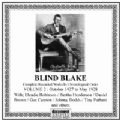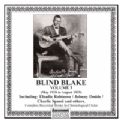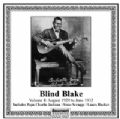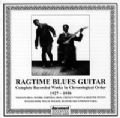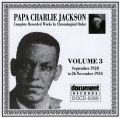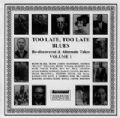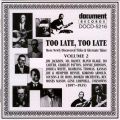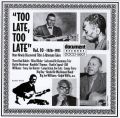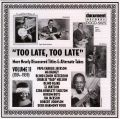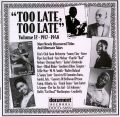"Search Document Records - Blind Blake Results "
Viewing 4 to 13 of 13
Blind Blake Vol 2 1927 - 1928 Blind Blake Vol 2 (October 1927 to May 1928)
Blind Blake, vocal, guitar, piano, possibly harmonica, whistle.
With contributions by: Gus Cannon, banjo; Johnny Dodds, clarinet; Jimmy Bertrand, slide whistle, xylophone; Elzadie Robinson, vocal; Bertha Henderson, vocal; Tiny Parham, piano, Daniel Brown, vocal; And others…
Genres: Ragtime Guitar, Country Blues Guitar.
Informative booklet notes by Alan Balfour.
Detailed discography.
It is Blake’s guitar playing abilities though that gives him his place in the development of a style that commentators now classify as “ragtime guitar”. A dazzling display of this technique can be heard on Southern Rag, a number which hints at his background and perhaps his influences. Accompanying himself with a series of chord changes and alternating thumbed bases he begins a spoken commentary which suddenly moves into the vernacular of the Gullah and Geechie peoples of the Georgia Sea Island, underpinned by a demonstration of an African rhythm on his guitar (“I’m goin’ to give you some music they call the Geechie music now”), finally lapsing back into his usual speech patterns. Continued... More Info on our New Store >> |
||
Blind Blake Vol 3 1928 - 1929 Blind Blake, vocal, guitar.
With contributions by; Elzadie Robinson, vocal, Charlie Spand, piano, Jimmy Bertrand, xylophone.
Genre: Country Blues, Ragtime Guitar, Blues Guitar
Informative booklet notes by Alan Balfour Includes detailed discography.
From this CD's booklet notes: By 1928 Blind Blake had gathered a faithful following, his appeal probably being due to the scope of his material, his popularity rivalling that of Blind Lemon Jefferson. The third volume in the series opens featuring Blind Blake in the role of sideman, lending his brilliant guitar leads in support of Elzadie Robinson on "Elzadie's Policy Blues" and "Pay Day Daddy Blues." Returning to recording under his own name, a session, or sessions, held during September 1928 seemed to find Blake obsessed by women and the problems they were causing him, at times sounding lachrymal and despondent “Search Warrant”, “Back Door”, desperate “Walkin’ Across The Country” and positively violent as in “Notoriety Woman”, “To keep her quiet I knocked her teeth out her mouth, that notoriety woman is known all over the south”. The final number recorded that month, “Sweet Papa Low Down”, with its cornet, piano and xylophone accompaniment, evoke the kind of bouncy tune popular with practitioners of the Charleston dance craze. It was to be a further nine months before Blake recorded again, this time in company with pianist Alex Robinson. The five titles cut were of a far less suicidal nature than previous and on one number in particular, “Doin’ A Stretch”, his approach owed much to the style of Leroy Carr. More Info on our New Store >> |
||
Blind Blake Vol 4 1929 - 1932 Blind Blake Vol 4 (August 1929 to June 1932)
Blind Blake, vocal, guitar.
With contributions by Papa Charlie Jackson, banjo; Irene Scruggs, vocal; and others...
Genres: Ragtime Guitar, Country Blues Guitar.
Informative booklet notes by Alan Balfour.
Detailed discography.
From this album's booklet notes:
Despite the name of Blind Arthur being used for two guitar solos recorded in October 1929, there can be little doubt that it is Blind Blake who is playing his "famous piano-sounding guitar" (to quote a Paramount advertisement) on Guitar Chimes. It has the same use of harmonics as in 'Police Dog Blues' (DOCD-5026) but played in the key of C and latterly commented on by a noted musicologist thus, "most country blues guitarists were not sufficiently well versed in C to have hazarded such an instrumental". Continued... More Info on our New Store >> |
||
Ragtime Blues Guitar 1927 - 1930 Various artists.
Genres: Ragtime guitar, Blues Guitar.
Informative booklet notes by Chris Smith.
Detailed discography.
Abridged from this CDs booklet notes.
The syncopated music that its black originators called “ragtime” was developed as a piano music in the last decade of the 19th Century, about the same time that the blues were also taking shape as a musical genre. Ragtime was a coming to terms between African cross-rhythms and the formalised syncopation of European art music and thus served equally as a vehicle for Scott Joplin's doomed ambition to be taken seriously and as a safely exotic craze for whites. Pop fashion moved on, to take up and dilute other black musical creations but ragtime entered the American folk consciousness, both white and black; in the Eastern states, particularly, it became a vital component in the sound of black blues, its lilting dance rhythms permeating, sometimes dominating, the ideas of the musicians of Virginia, the Carolinas, and Georgia. Controll... More Info on our New Store >> |
||
Papa Charlie Jackson Vol 3: September 1928 to November 1934 Papa Charlie Jackson, vocal, banjo, guitar.
With additional tracks by;
Ma Rainey and Papa Charlie Jackson
Hattie McDaniels And Dentist Jackson (Papa Charlie Jackson)
Papa Charlie Jackson and Blind Blake
Genres: Pre-war blues, Country Blues, Early Chicago blues, Female blues.
Informative booklet notes by Chris Smith.
Detailed discography.
Papa Charlie Jackson's last 25 recordings, dating from September of 1928 through November of 1934, and doing more proper blues here than on either previous volume. By the time of the release of the material here, Jackson was one of the most seasoned of studio bluesmen, with nearly half a decade recording experience behind him — his vocal presence on all of these records is extraordinary, and he knows how to get the most out of his instrument, guitar or banjo. Continued...
More Info on our New Store >> |
||
Too Late Too Late Blues 1926 - 1944 More Info on our New Store >> |
||
Too Late Too Late Vol 2 1897 - 1935 More Info on our New Store >> |
||
Too Late Too Late Vol 10 1926 - 1951 More Info on our New Store >> |
||
Too Late Too Late Vol 11 1924 - 1939 More Info on our New Store >> |
||
Too Late Too Late Vol 12 1917 - 1948 More Info on our New Store >> |
||

